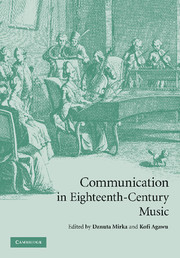Description
Communication in Eighteenth-Century Music
Coordinators: Mirka Danuta, Agawu Kofi
In this book, ten leading scholars of music explore the nature of musical communication in the eighteenth century.
Language: English
Communication in Eighteenth-Century Music
Publication date: 08-2012
Support: Print on demand
Publication date: 08-2012
Support: Print on demand
Communication in eighteenth-century music
Publication date: 07-2008
356 p. · 18.2x25.4 cm
Publication date: 07-2008
356 p. · 18.2x25.4 cm
Description
/li>Contents
/li>
Written by ten leading scholars, this volume assembles studies of eighteenth- and early nineteenth-century music under the broad rubric of communication. That such an impulse motivates musical composition and performance in this period of European musical history is often acknowledged but seldom examined in depth. The book explores a broad set of issues, ranging from the exigencies of the market for books and music in the eighteenth century through to the deployment of dance topoi in musical composition. A number of close readings of individual works by Mozart, Haydn and Beethoven draw on a sophisticated body of historically-appropriate technical resources to illuminate theories of form, metre, bass lines and dance topoi. Students and scholars of music history, theory and analysis will find in this volume a set of challenging, state-of-the-art essays that will stimulate debate about musical meaning and engender further study.
Foreword Danuta Mirka; Part I. Communication and the Market: 1. Communication and verisimilitude in the eighteenth century Paul Cobley; 2. Listening to listeners Mark Evan Bonds; 3. 'Mannichfaltige abweichungen von der gewöhnlichen sonaten-form': Beethoven's 'Piano-Solo' op. 31 no. 1 and the challenge of communication Claudia Maurer Zenck; Part II. Musical Grammar: 4. Metre, phrase structure and manipulations of musical beginnings Danuta Mirka; 5. National metrical types in music of the eighteenth and early nineteenth centuries William Rothstein; 6. Schoenberg's 'Second Melody', or, 'Meyer-ed' in the bass William E. Caplin; Part III. Rhetorical Form and Topical Decorum: 7. A metaphoric model of sonata form: two expositions by Mozart Michael Spitzer; 8. Beethoven's op. 18 no. 3, First Movement: two readings, with a comment on analysis Kofi Agawu; 9. K331, First Movement: once more, with feeling Wye J. Allanbrook; 10. Dance topoi, sonic analogs and musical grammar: communicating with music in the eighteenth century Lawrence Zbikowski; Afterword Kofi Agawu.
© 2024 LAVOISIER S.A.S.





